Bulletin – June 2018 Australian Economy Private Non-mining Investment in Australia
- Download 774KB

Abstract
While mining investment has risen in importance over recent decades, the non-mining investment share of output has fallen. This article explores some of the factors that have contributed to the downward trend in the non-mining investment share over time. The article finds that the future non-mining investment share could be around 1–2 percentage points lower on average than it was in the two decades before the financial crisis.
Over the past decade or so, Australia experienced a very large investment cycle as a result of the resources boom. Mining investment rose to a record share of GDP in 2012/13 but it has since fallen back to more usual levels. In contrast, although non-mining investment (in real terms) had been growing strongly up until around 2007, it was relatively flat for much of the next decade (Graph 1). It was surprising that, as the mining investment boom came to an end, investment in the rest of the economy did not pick up sooner. Only more recently has non-mining investment expenditure been increasing.
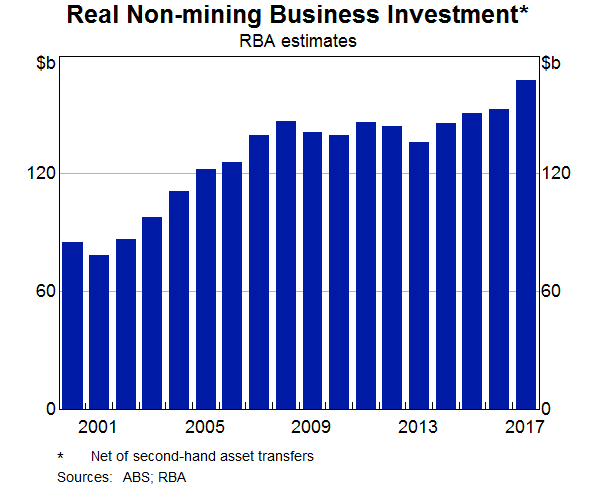
This article provides details about long-run and short-run trends in non-mining business investment and the drivers of these trends. It focuses mainly on nominal (rather than real) spending on investment as a share of GDP. Nominal data are considered more appropriate for longer-term analysis; comparing the level of real investment over time, particularly between categories, is complicated by the large changes in technology over recent decades and the significant shifts in the relative prices of investment goods that have accompanied these changes.
The nominal spending share of non-mining investment has fallen since the 1960s – from around 17 per cent of GDP to around 9 per cent in recent years, an historical low (Graph 2). An important question is the extent to which the decline in the nominal investment share has been driven by structural or cyclical factors. A large part of the long-term decline can be explained by changes in Australia's industry structure – namely, the shift away from investment in agriculture (mostly livestock) in the 1960s, and the trend decline in manufacturing. Both industries are relatively investment intensive. The decline in the relative price for certain investment goods has also contributed to the downward trend. Over the past decade or so, the decline in the nominal investment share has followed the onset of the financial crisis and the end of the mining boom. These two events appear to be important given that the fall in the investment share over the past decade has been broad based across non-mining industries and asset types; in combination, they also help explain why the downturn in the investment share has also been more protracted than seen in previous cycles. Ongoing changes in industry composition do not appear to provide much of the explanation for the recent decline in the investment share. That said, as discussed below, some aspects of the shift in industry composition are likely to result in a lower share of non-mining investment but a higher share of mining investment, on average, in the future.
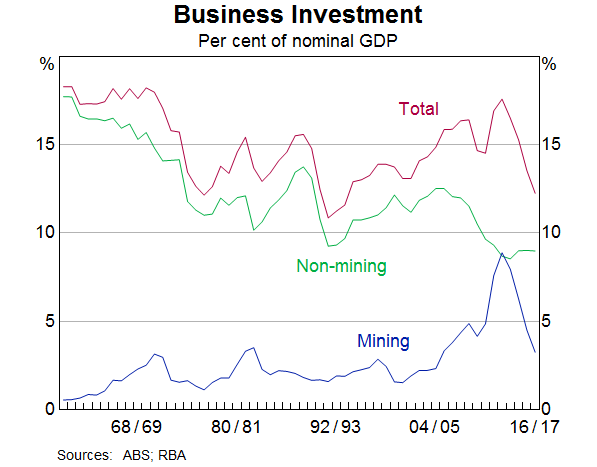
Long-run Drivers of the Declining Non-mining Investment Share
Two main factors appear to have contributed to the long-run decline in the non-mining investment share in Australia – changes in industry structure and technological change.
Industry structural changes
Changes in the industry structure of the Australian economy contributed to the decline in nominal spending on investment as a share of GDP between the 1960s and the 1990s. In the 1960s, agriculture and manufacturing together accounted for more than one-third of economic activity. The agriculture industry, particularly the wool industry, invested heavily in livestock at the time, but this fell significantly over the following decade (Graph 3).[1] The manufacturing industry's share of the economy has been in gradual decline since the 1960s. This has also contributed to the decline in the non-mining investment share given that the manufacturing industry is more investment intensive than other industries (Graph 4). As discussed below, the manufacturing industry has traditionally invested relatively more in machinery & equipment, which has a relatively high depreciation rate and therefore requires more ongoing investment.
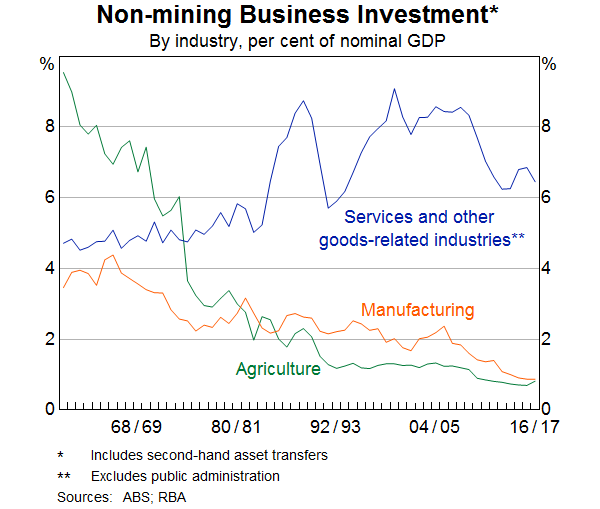
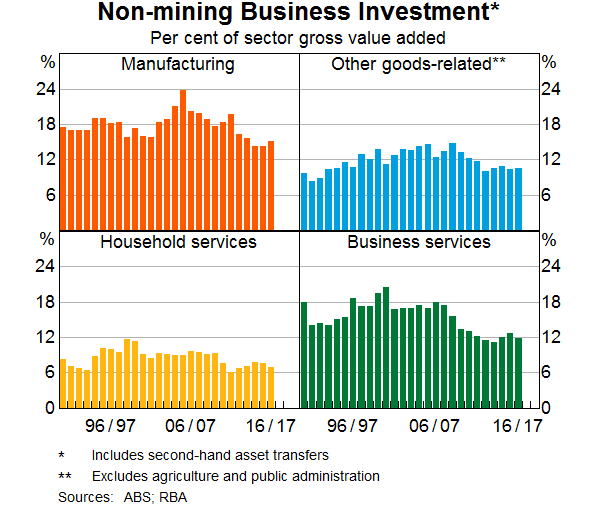
Since the early 1990s, though, industry shifts explain relatively little of the decline in this share. Changes in the non-mining investment share can be decomposed into ‘between industry’ effects (that are due to changes in sectoral composition) and ‘within industry’ effects (that are due to investment-to-output ratios within industries changing). The decomposition shows that only around a quarter of the decline in the investment share since the early 1990s (the earliest that the annual industry-level data are available) is due to a ‘between industry’ effect – that is, due to the changing industry mix (Graph 5). Indeed, the general shift towards a more service-oriented economy explains less of the between industry effect than is often assumed; in practice, investment intensity varies considerably across industries in both the goods and services sectors.
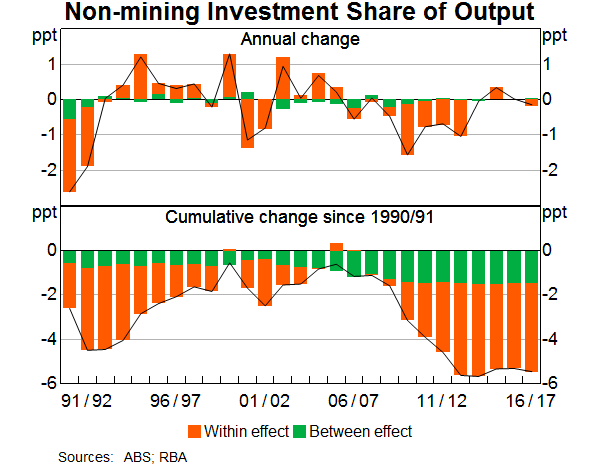
Since the mid 2000s, changes in industry composition have had only a small effect on the nominal share. Almost all of the change in the investment share has been due to within industry effects, and most of this occurred between 2009/10 and 2012/13. It is interesting to note that the cumulative within industry effect is around the same as was seen in the early 1990s recession. But a question arises as to why this is the case given the differences in the broader economic environments in these two episodes (for example, economic growth was considerably stronger in the more recent period compared with the early 1990s), and why the current decline has been more persistent. This is explored further below.
Although the decline in machinery & equipment investment over time has been largely due to the decline in the manufacturing industry's share of the economy, there has also been a change in the asset composition within manufacturing. For instance, the particularly pronounced decline in the nominal machinery & equipment investment share since the mid 2000s (Graph 6) has coincided with a period when the manufacturing sector has invested relatively less in machinery & equipment and more in intellectual property. This is consistent with information from the Bank's business liaison, which suggests some manufacturing firms have continued to undertake research and development or design work in Australia, but are shifting more of their production offshore.
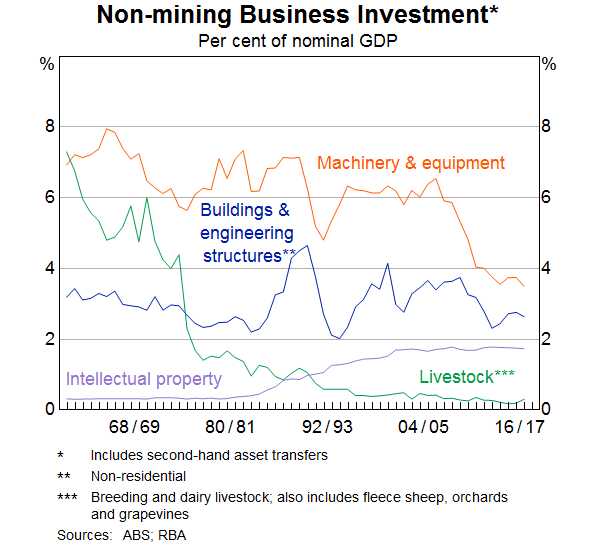
Implications for depreciation
A consequence of the shift in industry and asset composition is that there is now a larger share of longer-lived assets in the non-mining capital stock: buildings & engineering structures have asset lives of 30–50 years, while machinery & equipment have asset lives of 5–20 years. This has resulted in a decline in the average depreciation rate on the aggregate non-mining capital stock, which suggests that less ongoing investment may be required in the future to sustain the existing capital stock.[2]
If the current low level of the depreciation rate (of 6.7 per cent) were to continue, instead of returning to its rate before the financial crisis (of around 6.9 per cent), the average non-mining investment share could be around 0.3 percentage points lower in future.[3] It is possible, however, that firms take advantage of lower depreciation on some assets to invest more to expand their productive capacity.
The role of technological change
Technological change underlies much of the shift in industry composition and changes in the types of investment undertaken over time. This is because technological improvements change how goods and services are produced and can, in turn, affect the scale of production, the firm's competitiveness and its profitability. Technological change affects the relative cost of new capital versus labour, although how this affects the firm's investment share is not clear; some investments require people to work with them (‘labour augmenting’, such as for personal computers), while other investments replace workers (‘labour saving’, such as in the case of automation). Technological change also influences firms' decisions about whether to outsource certain operations or shift operations offshore and, ultimately, which types of activities will continue to be undertaken in Australia. The trend towards information technology (IT) being offered as a service (such as cloud computing) is a common example of outsourcing (and also often offshoring, in the cases where the servers are located outside of Australia). Investment is also shifted offshore if firms set up operations overseas or simply increase their use of imported inputs rather than producing those components themselves. Indeed, many global firms now operate global supply chains that involve firms using a network of fully or partially owned suppliers across various countries. This has typically occurred in the manufacturing sector as firms have shifted more of their manufacturing production offshore.
Falling computer prices
Rapid falls in the prices of computing and electronic equipment over recent decades are another consequence of technological change. Between the 1970s and mid 2000s, computer prices halved roughly every four or five years, when measured in constant quality terms. Over this same period, nominal investment in IT equipment as a share of output roughly doubled. Lower prices helped drive the increase in IT investment, but so too did the ongoing technological improvements and in-built obsolescence associated with system and software upgrades.
However, over the past decade, the value of investment in computers and electronics has more than halved as a share of output. This accounts for just under half of the fall in the share of spending on machinery & equipment investment over the past decade. In real terms, investment in IT equipment has also declined, occurring alongside the significant slowing in the pace of price falls for computers and electronics (Graph 7).
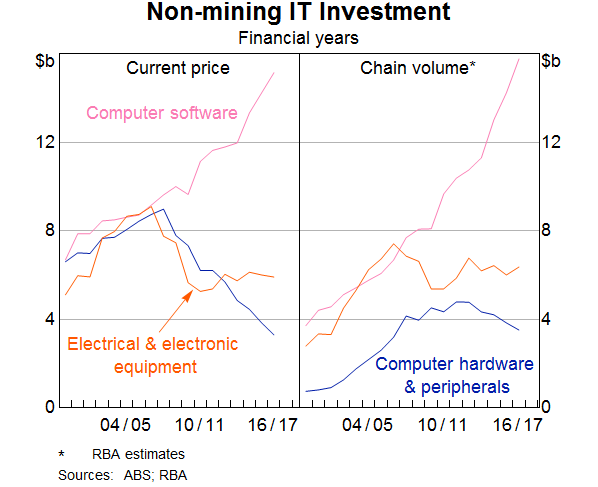
There are plausible reasons for this. Australian firms may have delayed IT investment in response to increasing cost pressures, while stabilising computer prices may have led some firms to delay upgrades as the cost of the investment was higher than expected; the slower rate of IT investment is also consistent with overseas evidence that the pace of innovation may have slowed. Alternatively, firms may have instead increased their spending on software (in-house or purchased) and/or systems development, which are treated in the national accounts as investment in intellectual property rather than machinery & equipment. Such investment has risen strongly over recent years.
Developments over the Past Decade
Weakness in non-mining investment after the onset of the global financial crisis in 2008 was common across advanced economies, and probably stemmed from its after-effects (Graph 8). In the United States, where the financial system was severely impaired during the crisis, non-mining investment has noticeably recovered; as a share of GDP, nominal investment has returned to around pre-crisis levels, suggesting the effects were largely temporary and have now been mostly unwound (Graph 9). Non-mining investment remains lower in the euro area, where the after-effects of the financial crisis have taken longer to resolve.
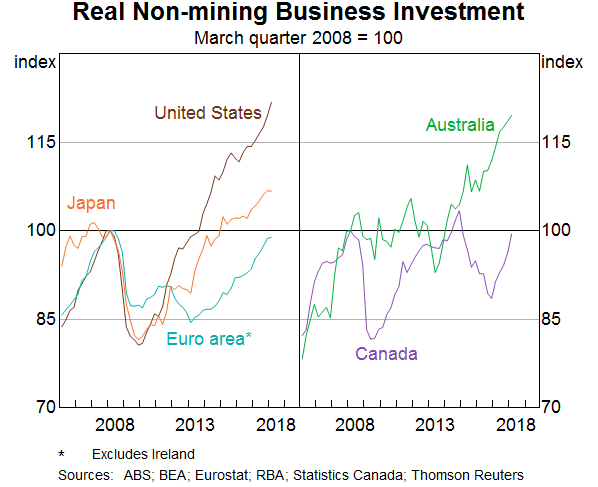
In Australia, non-mining investment did not fall significantly after the crisis; however, it was weaker than would have been expected given that economic growth held up reasonably well through this period. As already noted, non-mining investment in Australia has fallen as a share of GDP and this share remains below pre-crisis levels. It is unlikely that crisis-related effects on investment have been stronger or more long-lasting in Australia than in other economies. It is notable that the non-mining investment share has also remained lower in Canada, which, like Australia, had also experienced a resources investment boom. The persistence of a lower nominal investment share in both economies suggests that there have been spillover effects from the unwinding of the resources investment boom that have constrained growth in non-mining investment. In particular, higher commodity prices that led to a structurally higher real exchange rate may have dampened investment in some parts of the non-mining economy.
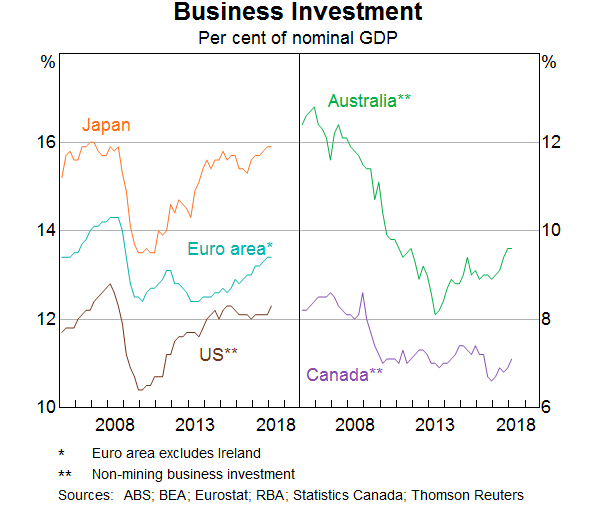
An alternative view is that (until recently) weak investment over the past decade in the major advanced economies was not so much a consequence of the crisis but instead the result of common structural factors; this view is typically referred to as ‘the secular stagnation hypothesis’ (Gordon 2015; Summers 2015). This view highlights the role of factors that could result in lower potential growth, such as the effects of a smaller workforce as a result of an ageing population, slower technological progress and increased regulation. Alternatively, lower growth could be the result of persistent shortfalls in demand if a lower neutral interest rate and high levels of household debt constrain the ability of central banks to bring the level of economic activity to a level consistent with full employment. But there is some circularity here, since less investment would also contribute to lower productivity growth and lower potential growth.
The role of the financial crisis
A slowing in investment growth across most advanced economies after the onset of the financial crisis suggests that there were some common factors weighing on investment. In particular, there is international evidence to suggest that the slowing in demand is likely to explain much of the observed decline in investment in many economies after the crisis (Banerjee, Kearns and Lombardi 2015; IMF 2015). In Australia, there was also a slowing in non-mining investment immediately after the crisis, which was broadly based across industries; however, it was surprising that investment did not recover more quickly, given the growth of aggregate demand. A number of factors related to the crisis could help explain this, including: a reduction in the availability of finance; reduced ‘animal spirits’ given increased uncertainty about the economic outlook or a reduced appetite for risk; and slow growth in real wages, reducing the incentive to replace labour with capital.
Availability of finance
The global availability of finance was more constrained after the crisis, including in Australia. But financing constraints are unlikely to still be an important factor for most Australian firms 10 years after the onset of the crisis. Borrowing costs have been low and the Bank's liaison with medium to large firms suggests that the cost and availability of finance have improved over the past five years and have not weighed on investment decisions (Connolly and Jackman 2017). The availability of internal funding has also improved more recently, with profits in the non-mining business sector increasing over the past year. Internal funds are an important source of finance for investment because they are typically cheaper and may be more readily available than other funding sources. However, there is some evidence from Bank liaison that firms may set high expected returns (or ‘hurdle rates’) on capital expenditure that are well above the cost of capital and do not change very often, which could limit investment even when interest rates are low (Lane and Rosewall 2015).
The availability of external finance may have been more of a constraint for smaller firms, though, because they have less capacity to self-finance. Information collected through the Bank's Small Business Panel indicates that small and medium enterprises have faced difficulty in obtaining finance from banks in recent years. Also, while interest rates have fallen for large borrowers, interest rates paid by smaller and riskier firms have remained at around their pre-crisis levels, despite large declines in funding rates (Hambur and La Cava 2018). There is some supporting evidence from the Australian Bureau of Statistics' (ABS) BLADE database that small business investment has been unusually weak since the crisis; panel models of investment by firm size have shown that investment by large firms can be largely explained by a slowing in demand conditions, while investment spending by small firms has been low relative to demand, which would be consistent with these firms facing financing constraints.[4]
Animal spirits
Another suggested explanation for the post-crisis weakness in investment is reduced animal spirits. Animal spirits are generally thought to cover at least three elements: expectations about the most likely outcome; uncertainty about the range of possible outcomes; and appetite for risk (or risk aversion). The return of investment shares to pre-crisis levels in some of the major advanced economies suggests that animal spirits may be returning in these economies.
For some time after the financial crisis, the Bank's liaison program had pointed to businesses being reluctant to invest until they saw a sustained pick-up in demand. Many of these firms also required the investment outlay to be recouped within a few years, suggesting that expectations of weak future conditions could have restrained non-mining business investment, rather than current conditions. It is less clear that increased uncertainty has been as important for investment in Australia, because most measures of uncertainty have remained at relatively low levels in recent years.
There is some evidence that risk aversion among firms and financial investors may have risen since the financial crisis, and could be more enduring. Firms have been reluctant to reset investment hurdle rates (despite falls in borrowing rates). The reduction in firm gearing levels and increased cash holdings could represent increased risk aversion by firms but might have also been driven by increased risk aversion of investors. There is also the potential for ‘short-termism’ among investors, which may have reinforced the tendency of Australian corporates to pay high dividends.
After the onset of the financial crisis, Australian subsidiaries of foreign parents in the Bank's liaison program also reported that some profitable projects had not gone ahead. For those multinational parents located in crisis-affected economies, risk and investment appetite is likely to have declined given the very weak economic conditions in their domestic economies and expectations that these weaker outcomes could persist. That some profitable projects had not gone ahead may have also partly reflected the approval process, which typically involves the parent entity setting a global budget for investment and distributing the pool of funds based on a global ranking of potential projects.
Spillovers from the mining sector
A key point of difference for Australia compared with most other economies in the past 10–15 years has been the mining boom. It is likely that spillovers from the mining sector have contributed to the currently low nominal non-mining investment share in Australia.
The investment undertaken by the mining sector had a range of direct spillover effects for exposed non-mining industries. In the upswing of the boom, positive spillovers included an increase in demand for construction, business services and a range of other inputs, with these particularly strong in Queensland and Western Australia (see, for instance, Langcake and Poole (2017) and Rayner and Bishop (2013); Graph 10). The end of the mining investment boom has been a drag on the Australian economy in recent years, and there have been clear spillover effects to weaker non-mining investment in the states most directly exposed to the mining sector (Graph 11). However, more recently, investment in other states has picked up and expectations of future economic conditions have improved, which may mean the drag associated with the decline in mining investment is diminishing.
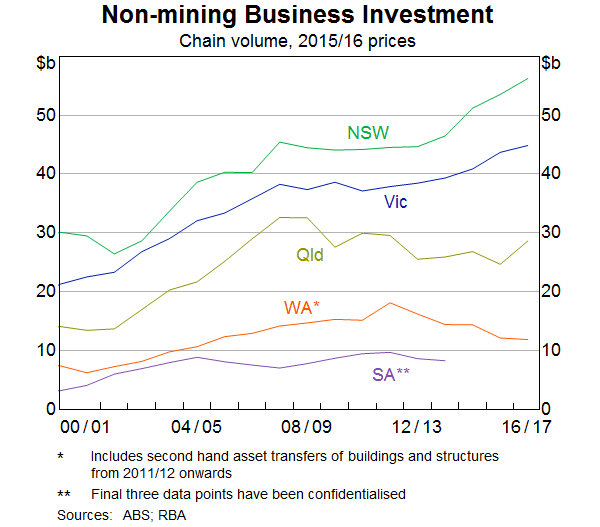
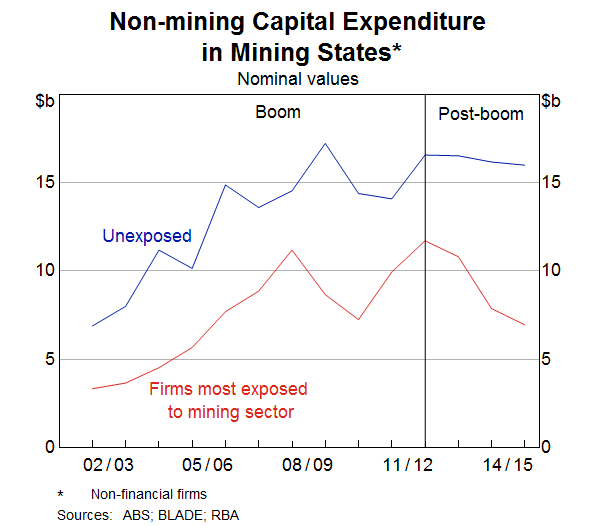
Structurally higher exchange rate
A more persistent effect of the mining boom has been the increase in Australia's terms of trade and, relatedly, a higher trade-weighted exchange rate. The real exchange rate is currently around 30 per cent higher than its 1990–2005 average, although it has depreciated by around 15 per cent since its peak in 2013. Australia's terms of trade are expected to remain elevated compared with history before the current episode, which, all else being equal, should support a higher exchange rate (Graph 12).
A higher exchange rate could affect the mix of industries in Australia, particularly as it will have reduced the competitiveness of some exporting firms and some domestic firms that compete with imported goods and services. On the other hand, a higher exchange rate makes imported capital goods cheaper and, in some cases, could have encouraged investment to improve domestic productivity. As such, it could take some time for the final effect from a higher exchange rate on the nominal investment share to be apparent.
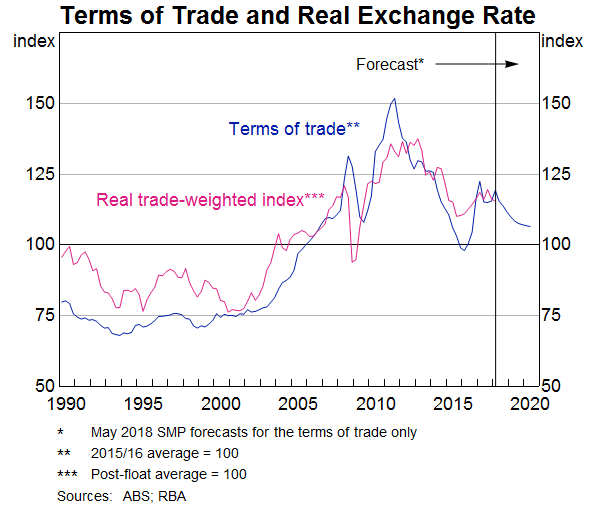
Where to from Here?
In real terms, non-mining investment has risen strongly in recent years, suggesting that some of the cyclical factors that have been weighing on it have eased. Moreover, survey measures of business conditions, investment intentions and capacity utilisation have risen to be back around (or above) their pre-crisis levels. The drag from the mining investment boom is close to an end and there are also signs of activity recovering in the states that are most exposed to mining activity, which support the outlook for investment there. Public sector investment is expected to be strong over the next few years and, given the current spare capacity in the economy, the increase is expected to have positive spillover effects for private investment (RBA 2018).
However, some of the longer-run structural factors that have affected the nominal investment share could have ongoing effects. The shift away from manufacturing (most evident in machinery & equipment) and livestock-based farming has contributed to the decline in the non-mining investment share over the past six decades. The manufacturing industry has also invested relatively less in machinery & equipment and more in intellectual property over the past decade.
In order to gauge the significance of this, it is useful to consider what the nominal investment share would be over the longer term if these changes in industry composition (and their asset mix) persist but other types of investment are assumed to return to their long-run averages. In this scenario, the non-mining investment share could be around 1 to 2 percentage points lower than it was on average in the two decades before the financial crisis (Graph 13).[5] This does not mean that the ratio of total investment to GDP will necessarily decline by this amount because, offsetting this, mining investment is expected to be around ½–1½ percentage points of GDP higher than it was before the mining boom, on the expectation that mining firms will invest to maintain the increased share of total production and offset depreciation (Jenner et al 2018).[6]
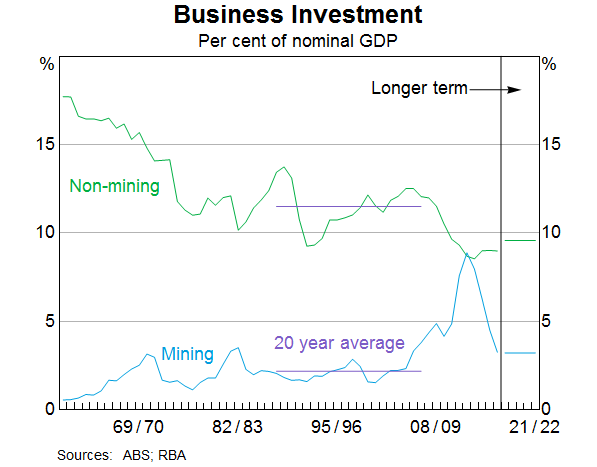
Other trends that may be affecting investment decisions and the competitive environment in which firms operate include the rate of innovation (with some US evidence that this has been slowing), the adoption rate for new technologies, the rise of low wage economies in an increasingly globalised economy and a smaller workforce as a result of ageing demographics. How these will affect the investment intensity of production in Australia is hard to predict. It will also depend on other factors, such the rate at which Australia (and other economies) invests in education and public infrastructure. These changes will have implications for medium-term rate of growth in the economy, but it is also important to note that there is no predetermined level of the investment share that is required to sustain productivity or potential growth and achieve a certain a level of economic welfare.
Footnotes
Michelle van der Merwe, Lynne Cockerell and Mark Chambers are from Economic Analysis Department; Jarkko Jääskelä completed this work in Economic Analysis Department. The authors would like to thank Keaton Jenner, Daniel Rees, Gianni La Cava, Alex Baker and Tom Rosewall for their helpful comments. This article has also benefited from earlier internal work by Stephen Elias, Gareth Spence, Leon Berkelmans, Jonathan Hambur, Keaton Jenner and Gianni La Cava. [*]
It is a feature of the data that livestock used for ongoing production (such as fleece sheep, dairy cows, breeding cattle) are treated as investment, whereas livestock raised for slaughter are considered intermediate inputs into production. [1]
Depreciation is the amount of firms' capital that is ‘used up’ from normal wear and tear, foreseen obsolescence (for instance, which occurs when a new computer model is released with superior performance to a previous model but is not commensurately more expensive) and the normal amount of damage that is not repaired. The Australian Bureau of Statistics (ABS) does not directly measure economic depreciation – for example, depreciation does not change as a result of firms using machinery more intensively – but rather calculates depreciation based on a series of fixed assumptions that vary by asset type and industry. [2]
Under the assumption of a balanced growth path where the long-run rate of output growth and the long-run ratio of capital to output remain unchanged. [3]
The BLADE (Business Longitudinal Analytical Data Environment) database contains matched administrative and ABS survey data for (almost) all Australian firms with data available from 2002 to 2015. It includes annual data on capital purchase, sales, capital stock, wages and a number of other variables. See disclaimer at the end of this article. [4]
A number of recent trends – such as continued specialisation in developing intellectual property or more of an increase in automation – could contribute to a greater increase in the nominal investment share than assumed in the scenario; although the size (and even the direction) of these effects is uncertain. [5]
The ‘longer term’ mining investment share of output shown in Graph 13 is the midpoint of the range of estimates outlined by Jenner et al 2018. [6]
References
Banerjee RN, J Kearns and M Lombardi (2015), ‘(Why) Is Investment Weak?’, BIS Quarterly Review, March.
Connolly E and B Jackman (2017), ‘The Availability of Business Finance’, RBA Bulletin, December, pp 55–66.
Gordon R (2015), ‘Secular Stagnation: A Supply-side View’, The American Economic Review, 105(5), pp 54–59.
Hambur J and G La Cava (2018), ‘Do Interest Rates Affect Business Investment? Evidence from Australian Company-level Data’, RBA Research Discussion Paper No 2018-05.
IMF (International Monetary Fund) (2015), ‘Chapter 4. Private Investment: What's the Holdup?’, World Economic Outlook, April, pp 111–144.
Jenner K, A Walker, C Close and T Saunders (2018), ‘Mining Investment Beyond the Boom’, RBA Bulletin, March.
Lane K and T Rosewall (2015), ‘Firms' Investment Decisions and Interest Rates’, RBA Bulletin, June, pp 1–8.
Langcake S and E Poole (2017), ‘The Resources Economy and the Terms of Trade Boom’, RBA Bulletin, September, pp 27–34.
Rayner V and J Bishop (2013), ‘Industry Dimensions of the Resource Boom: An Input-output Analysis’, RBA Research Discussion Paper No 2013-02.
RBA (Reserve Bank of Australia) (2018), ‘Box C: Spillovers from Public Investment’, Statement on Monetary Policy, February, pp 40–42.
Summers L (2015), ‘Rethinking Secular Stagnation After Seventeen Months’, Speech given at the IMF Rethinking Macro III Conference, Washington DC, 16 April.
Disclaimer
The results of these studies are based, in part, on ABR data supplied by the Registrar to the ABS under A New Tax System (Australian Business Number) Act 1999 and tax data supplied by the ATO to the ABS under the Taxation Administration Act 1953. These require that such data are only used for the purpose of carrying out functions of the ABS. No individual information collected under the Census and Statistics Act 1905 is provided back to the Registrar or ATO for administrative or regulatory purposes. Any discussion of data limitations or weaknesses is in the context of using the data for statistical purposes, and is not related to the ability of the data to support the ABR or ATO's core operational requirements. Legislative requirements to ensure privacy and secrecy of this data have been followed. Only people authorised under the Australian Bureau of Statistics Act 1975 have been allowed to view data about any particular firm in conducting these analyses. In accordance with the Census and Statistics Act 1905, results have been confidentialised to ensure that they are not likely to enable identification of a particular person or organisation.